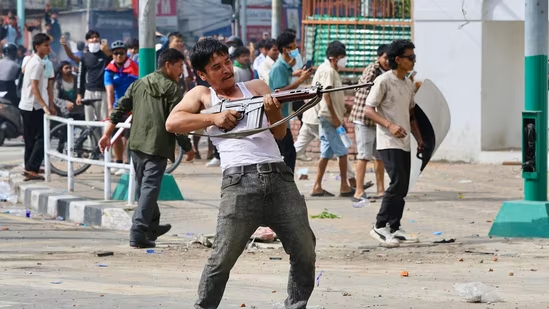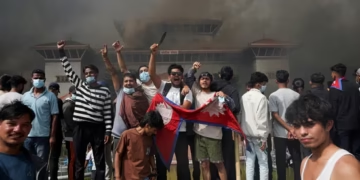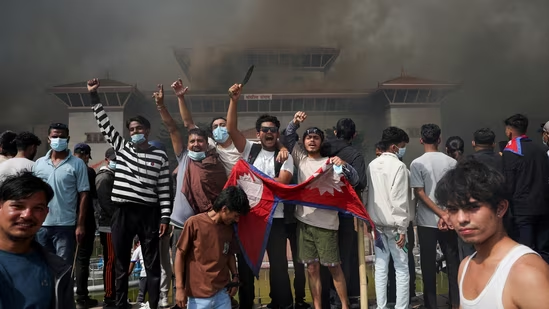Uttar Pradesh has heightened security across its seven border districts following violent ‘Gen Z’ protests in Nepal. The unrest has led to casualties and disrupted cross-border movement. Authorities are on high alert to prevent escalation.

High Alert in UP Border Towns Amid Nepal’s ‘Gen Z’ Protests
Introduction
The ongoing ‘Gen Z‘ protests in Nepal have escalated into a full-blown crisis, prompting the Uttar Pradesh (UP) government to declare a high alert across its seven border districts. The unrest, primarily driven by youth-led demonstrations against corruption and a controversial social media ban, has led to significant casualties and widespread destruction in Nepal. In response, Indian authorities are intensifying security measures to prevent any spillover effects into India.
The Genesis of the Protests
The protests erupted after the Nepalese government’s decision to impose a sweeping ban on several social media platforms, including Facebook, YouTube, and X (formerly Twitter). This move was perceived as an infringement on democratic rights and freedom of expression, particularly among the youth. The situation escalated when Prime Minister KP Sharma Oli resigned amid mounting public pressure and violent protests. Protesters stormed government buildings, including the Parliament and the President’s office, setting them ablaze. At least 19 people have been killed, and over 500 injured in the clashes.
Impact on Uttar Pradesh Border Districts
In response to the escalating situation, the UP government has heightened security across its seven border districts: Maharajganj, Siddharthnagar, Balrampur, Shravasti, Bahraich, Lakhimpur Kheri, and Pilibhit. A special control room has been established at the Police Headquarters in Lucknow to assist Indian nationals stranded in Nepal. Three helpline numbers, including a WhatsApp number, are operational 24/7: 0522-2390257, 0522-2724010, and 9454401674 .
Security forces, including the Sashastra Seema Bal (SSB) and Provincial Armed Constabulary (PAC), have intensified patrolling and surveillance in all border districts. In the Devipatan Division, 73 check posts have been activated, and night patrols have been bolstered. Similar measures, including identity checks and deployment of additional forces, are in place in other districts to maintain peace and prevent infiltration or escalation due to the ongoing crisis in Nepal.
Disruption of Cross-Border Movement
The unrest in Nepal has significantly disrupted cross-border movement. In Gorakhpur, the tourism sector has been hit hard due to violent clashes and a curfew in Nepal, leading to a high alert at the Indo-Nepal border in Sonauli. Authorities have ramped up security, thoroughly inspecting travelers and vehicles, with a sharp focus on identity verification. This unrest has reduced passenger traffic between Gorakhpur and Sonauli, with bus ridership falling by 30-50%. Many Gorakhpur residents travel to Nepal for tourism and medical care, especially eye treatments, but the current situation has led to widespread trip cancellations.
Humanitarian Concerns
The protests have not only led to political instability but have also raised humanitarian concerns. Around 40 tourists from Kozhikode and Malappuram districts in India were stranded in Nepal due to the ongoing ‘Gen Z’ protests. The unrest disrupted their travel, leaving them stuck at Goshala, near Kathmandu, where roads were blocked, and tires were burned by demonstrators. The Indian External Affairs Ministry has advised Indian nationals to postpone travel to Nepal and urged those already in the country to remain indoors and exercise caution amid the unrest.
Cultural and Emotional Impact
The unrest has also affected communities with strong cultural and familial ties to Nepal. In Pithoragarh, Uttarakhand, a district that shares deep ‘roti-beti’ (bread and daughter) relations with Nepal, residents are worried for their relatives living across the border. Reports detail chaos and arson in Nepal, including the torching of the Parliament, Supreme Court, and other government offices in Kathmandu. Trade and movement across the traditionally open border have drastically reduced. Authorities in India have tightened border security and increased patrols to ensure the safety of residents and prevent any potential escalation.
Government Response and Future Outlook
The Indian government is closely monitoring the situation and has expressed concern over the escalating violence in Nepal. While the border remains open, strict security protocols are in place to maintain peace and prevent infiltration or escalation due to the ongoing crisis in Nepal. The situation remains fluid, and authorities are prepared to take further measures as necessary to ensure the safety and security of Indian nationals and maintain law and order in the border regions.
The ‘Gen Z’ protests in Nepal have not only led to significant political upheaval but have also disrupted cross-border relations and raised humanitarian concerns. The heightened security measures in Uttar Pradesh’s border districts reflect the seriousness with which Indian authorities are treating the situation. As the situation continues to evolve, it is crucial for both governments to engage in dialogue and take steps to ensure stability and peace in the region.
READ ALSO…..Prithvi Shaw Fined ₹100 by Mumbai Court in Sapna Gill Molestation Case; Final Chance Granted















 Categories
Categories









